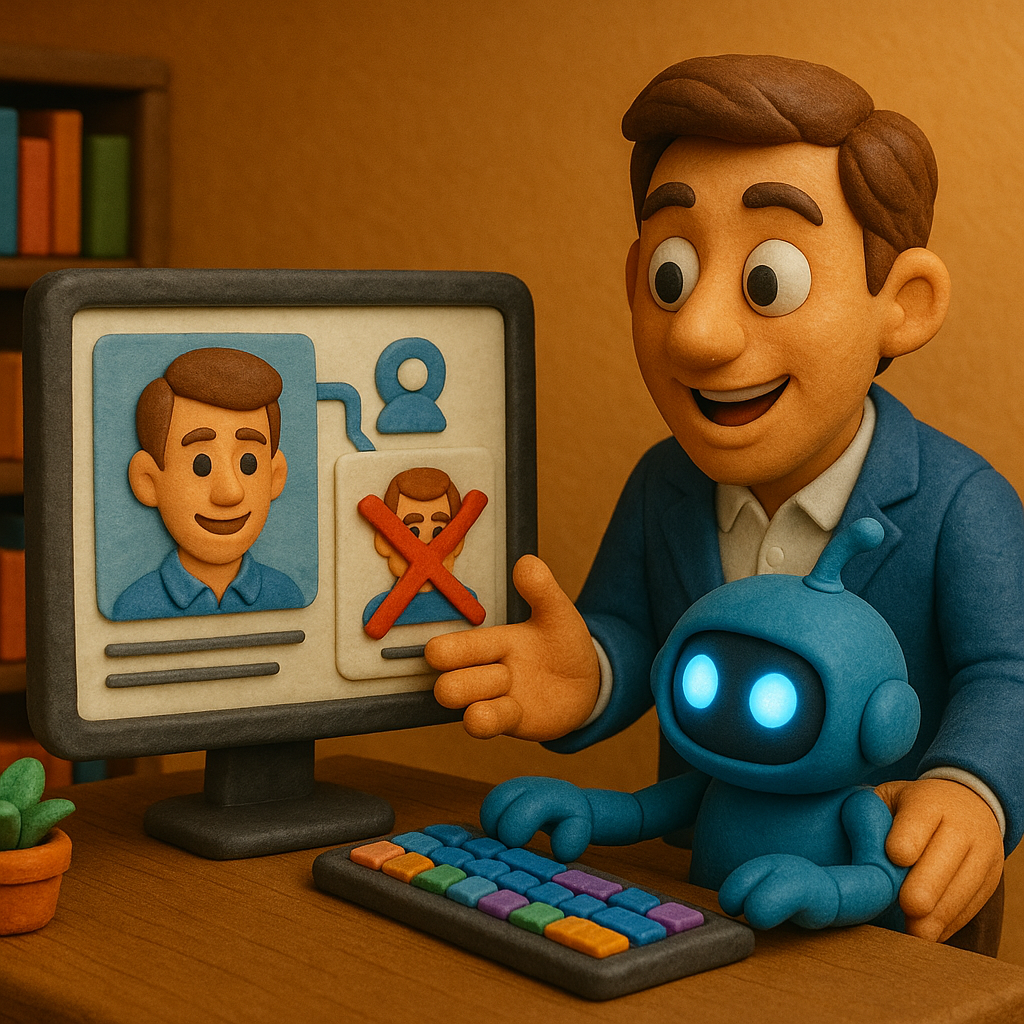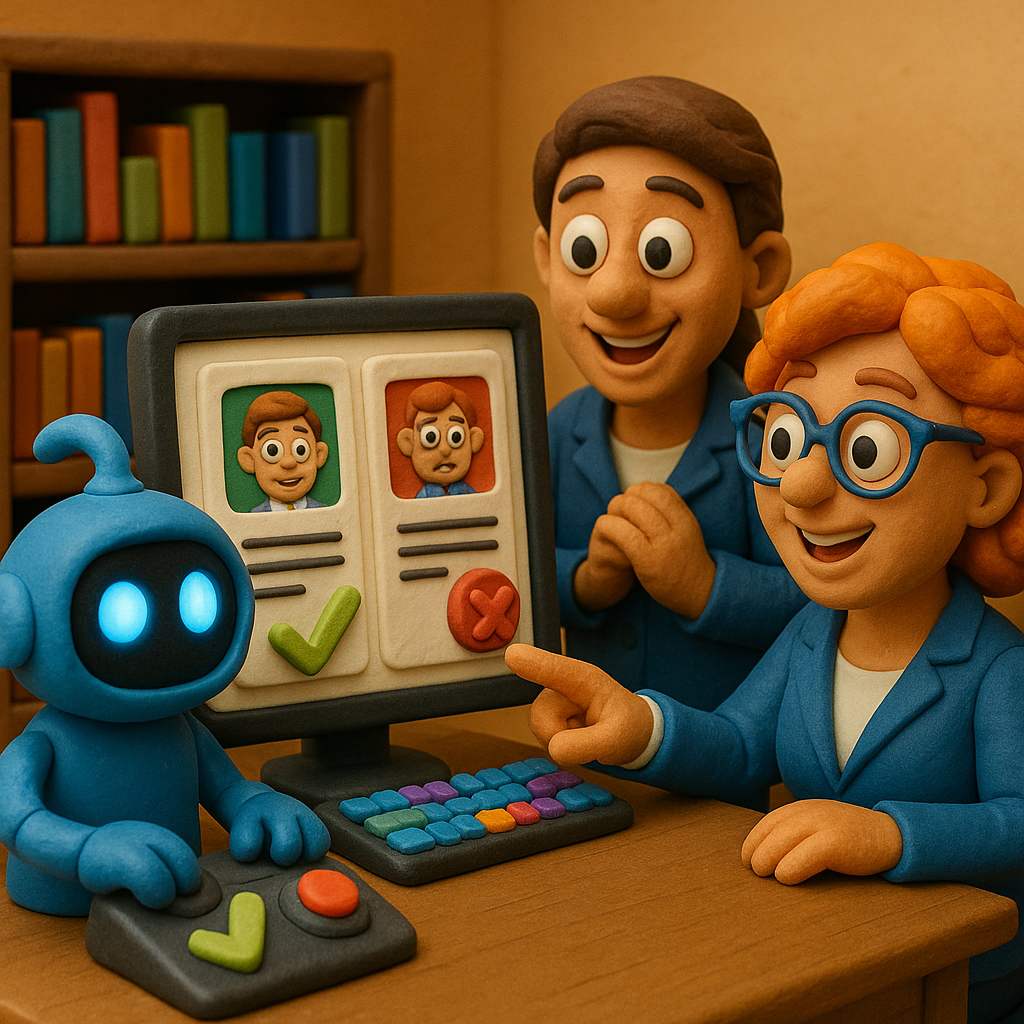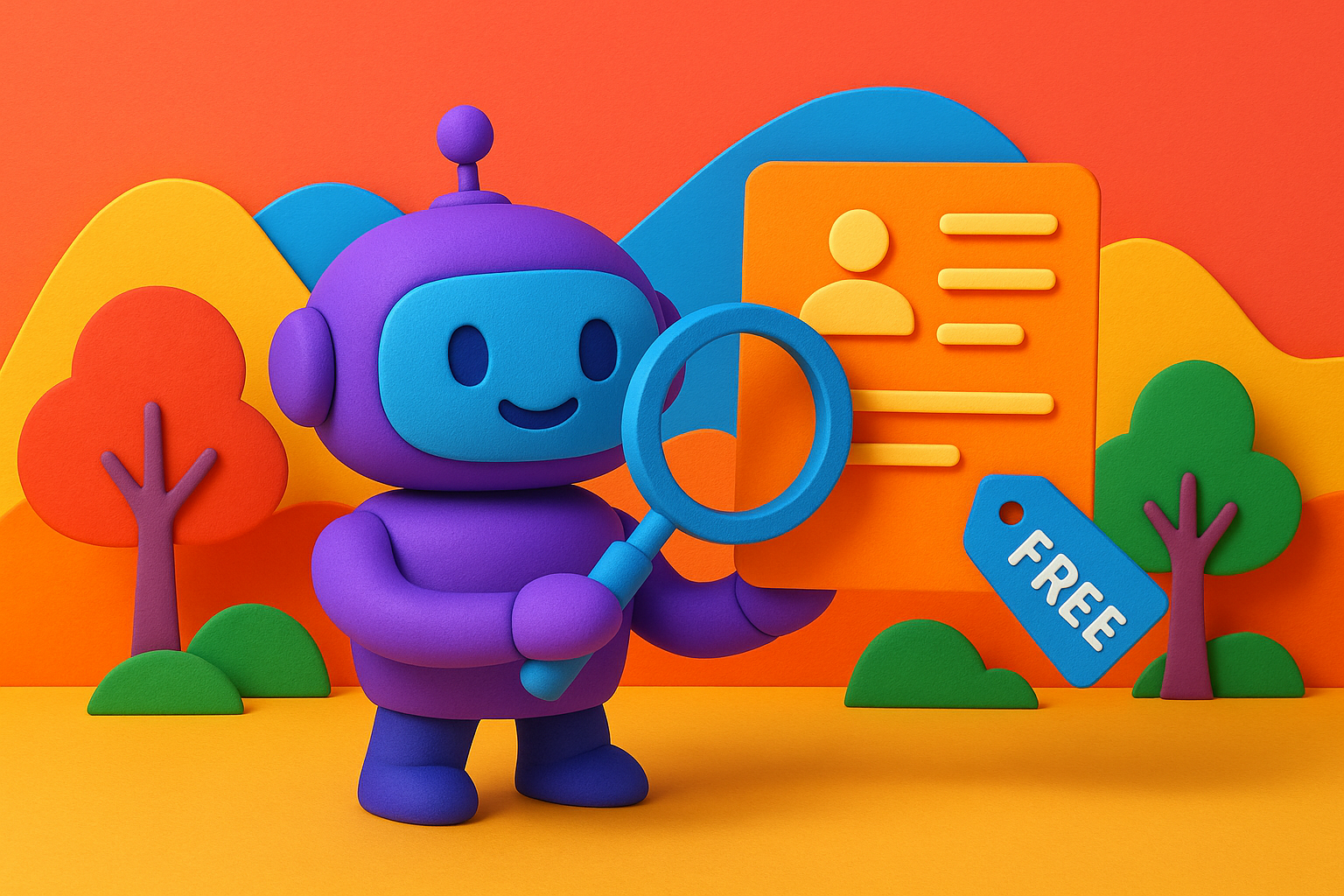
Why Free Resume Screening Software Delivers Better ROI Than Premium Tools
Why Free Resume Screening Software Delivers Better ROI Than Premium Tools
Published on November 9, 2025 · Q&A format · Real talk about costs, features, and why your recruiting budget might be better off elsewhere.

Q: Wait, free software can actually deliver better ROI than tools costing $10K+/year?
Yes—and it's not even close for most companies.
Here's the math: If you're a 50-person company hiring 20 people/year, premium ATS + AI screening runs $8,000-15,000 annually. That's $400-750 per hire in software costs alone.
A free AI recruitment software tool with the same core features costs $0. Your ROI is literally infinite.
Even if the free tool is 80% as good (spoiler: modern free tools are often 95%+ feature-equivalent), you're saving thousands that could go toward better job ads, referral bonuses, or faster hiring—things that actually improve candidate quality.
The premium tools' value prop is enterprise-scale features (custom integrations, dedicated support, compliance reporting). If you're not hiring 200+ people/year, you're paying for capabilities you'll never touch.
Q: What's the actual cost breakdown of premium vs free resume screening tools?
Let's compare apples to apples. Small company (30 employees, hiring 15-20 people/year):
Premium AI Resume Screening Tool (HireVue, Pymetrics, etc.)
- Base subscription: $6,000-12,000/year
- Per-candidate fees: $5-20 per screened candidate (so 200 candidates/year = $1,000-4,000 extra)
- Implementation/training: $2,000-5,000 one-time
- Integration setup: $500-2,000 if your ATS isn't pre-built
- Premium support: $1,200-3,000/year (or you're stuck with email-only support)
- Annual total: $10,700-26,000
Free AI Recruitment Software (like ours, or open-source alternatives)
- Base subscription: $0
- Per-candidate fees: $0 (up to reasonable limits, like 500-1000 resumes/month)
- Implementation: Self-service onboarding, 15-30 minutes
- Integrations: API or Zapier (Zapier costs $20-50/month if you automate, so $240-600/year)
- Support: Community forums, documentation, email (surprisingly good in 2025)
- Annual total: $0-600
Savings: $10,100-25,400/year. That's a junior recruiter's salary. Or 50 employee referral bonuses. Or 200 LinkedIn Recruiter InMails.
Q: But surely premium tools have way better features, right?
Not anymore. The feature gap closed dramatically in 2023-2025.
Modern free AI recruitment software tools offer:
- Resume parsing: Extract name, email, phone, skills, experience from PDF/DOCX (accuracy: 92-96%)
- AI scoring: Match candidates against job requirements using NLP models trained on millions of resumes
- Bulk processing: Upload 50-200 resumes at once, get results in 2-5 minutes
- Custom scoring criteria: Define must-have vs nice-to-have skills, weight experience levels
- API access: Integrate with your existing tools (ATS, Slack, email, Airtable)
- Candidate redaction: Remove bias-inducing info (names, photos, universities) before human review
- Export to CSV/JSON: Take your data anywhere, no lock-in
Premium tools add:
- Video interview analysis: AI scores candidate video responses (useful if you do async video screens)
- Behavioral assessments: Cognitive tests, personality profiles (ROI questionable—many orgs abandon after 6 months)
- White-glove support: Dedicated success manager, custom training
- Advanced compliance: OFCCP reporting, EEOC audit logs (only matters if you're a federal contractor or 500+ employees)
- Custom ML models: Train on your past hires to improve predictions (needs 500+ hiring data points to be meaningful)
For 80% of companies, that premium list is nice-to-have, not need-to-have. You're paying 20x more for features you'll use <20% of the time.
Q: What about accuracy—do free tools miss good candidates or let bad ones through?
Let's look at real-world data. Studies from 2024 recruiting benchmarks:
- Premium AI screening false positive rate: 12-18% (candidates scored high but bombed interviews)
- Free AI screening false positive rate: 15-22%
- Premium false negative rate: 8-14% (good candidates rejected by AI)
- Free false negative rate: 10-16%
The difference? 3-4 percentage points. On a pipeline of 100 candidates, that's maybe 3-4 extra misfires.
But here's the thing: Human recruiters have a 25-35% false positive rate when manually screening. Both premium and free AI crush manual screening by a mile.
The quality gap between premium and free AI tools is smaller than the noise in your hiring process. Job description clarity, interview rubrics, and hiring manager alignment matter 10x more than the 3% accuracy delta.
Q: When does it actually make sense to pay for premium resume screening software?
Fair question. Premium tools shine in specific scenarios:
1. High-volume hiring (200+ hires/year)
At scale, the per-candidate cost of premium drops, and advanced features (bulk scheduling, sophisticated routing, multi-stage workflows) save real time. If you're screening 10,000 resumes/year, paying $15K for software that saves 500 recruiter hours is a no-brainer.
2. Regulated industries (finance, healthcare, government contracting)
You need audit trails, EEOC compliance reports, adverse impact analysis. Premium tools handle this out-of-the-box. Free tools require custom setup (doable, but time-intensive).
3. Complex assessment needs
If your hiring process includes behavioral tests, coding challenges, or video interviews, all-in-one premium platforms (HireVue, Codility, TestGorilla) centralize everything. Free tools require stitching together 3-4 separate services (more manual work).
4. You have zero technical resources
Premium tools include white-glove onboarding, training, and ongoing support. If your team can't spend 2-3 hours learning APIs or Zapier, that convenience might be worth the cost.
5. Custom ML models matter
If you have 500+ past hires with outcome data (performance reviews, retention), premium tools can train models specific to your company. ROI is real but only at scale.
For everyone else—startups, small businesses, teams under 100 people—free tools deliver 90% of the value at 0-5% of the cost.
Q: What are the hidden costs of free resume screening tools I should watch out for?
Good question—"free" isn't always 100% free. Watch for:
1. Usage limits
Many free tiers cap at 50-100 resumes/month. If you're hiring aggressively, you'll hit limits and need to upgrade. Check the ceiling before committing.
2. Missing integrations
Premium tools have native ATS integrations. Free tools often require API work or Zapier (adds $20-50/month). Factor this in—still way cheaper than premium, but not zero.
3. Time spent on setup
Free tools are self-service. Onboarding takes 30-90 minutes vs 2-hour guided session with premium. If your hourly rate is high enough, this gap matters (but probably still favors free).
4. Support responsiveness
Premium gets you Slack/phone support. Free gets you email or community forums. If you need answers NOW, premium might save your sanity during crunch hiring.
5. Data portability headaches
Some free tools lock you into their format. Switching later requires CSV wrangling. Premium tools often have migration services. Ask about export formats upfront.
Bottom line: Even with hidden costs, free tools typically run $500-1,500/year all-in. Premium runs $10K-30K. Free still wins on ROI for most teams.
Q: How do I calculate ROI for my specific hiring situation?
Use this formula:
ROI = (Time Saved × Hourly Rate) + (Quality Improvement × Hire Value) - Tool Cost
Example: 30-person company, hiring 20 people/year
Manual screening baseline:
- 200 applications/year
- 8 minutes per resume (reading, scoring, notes) = 1,600 minutes = 26.7 hours
- Recruiter hourly rate: $50/hr (loaded cost)
- Annual cost: $1,335
With free AI recruitment software:
- AI screens 200 resumes in 15 minutes total (bulk upload)
- Recruiter reviews top 50 candidates (AI pre-filtered) at 3 minutes each = 150 minutes = 2.5 hours
- Time saved: 24.2 hours
- Cost savings: $1,210/year
- Software cost: $0-300/year (if using Zapier integrations)
- Net savings: $910-1,210/year
With premium tool:
- Same time savings (24.2 hours)
- Cost savings: $1,210/year
- Software cost: $12,000/year
- Net loss: -$10,790/year
The premium tool costs more than it saves in this scenario. Free tool has positive ROI. Math doesn't lie.
When premium wins:
If you're screening 2,000 resumes/year (10x volume), time saved = 242 hours = $12,100. Premium tool at $12K breaks even, and its advanced features (better filtering, less false positives) might push you into positive ROI. At 3,000+ resumes/year, premium clearly wins.
Q: Can I start with free and upgrade later, or will I regret it?
Start free, upgrade if needed. Here's why:
Low switching cost
Most modern tools (free and premium) export candidate data as CSV or JSON. Migration takes hours, not weeks. You're not locked in.
Learn what you actually need
Using a free tool for 3-6 months teaches you which features matter (bulk upload? Custom scoring? API access?) and which are marketing fluff. You'll make a smarter premium purchase if you eventually upgrade.
Prove ROI first
Run free tool for a quarter. Measure time saved, quality of hires, recruiter satisfaction. If ROI is great, you justified your current setup. If you're hitting limits, you have data to justify premium budget to your CFO.
Hybrid approach
Many teams use free AI screening for 80% of roles (standard positions, high volume) and premium for 20% (executive hires, specialized roles). Best of both worlds.
Regret risk is low. Worst case: you spend 2-3 hours migrating data and learning a new tool. Best case: you save $10K+/year forever.
Q: How do free tools make money if they're not charging me?
Good to understand the business model so you know what to expect:
1. Freemium upsells
Free tier gets you core features (parsing, scoring, basic API). Premium tier ($50-200/month) adds higher usage limits, advanced analytics, priority support. Most users stay free; 5-10% convert.
2. Volume-based pricing
Free up to 100 resumes/month. After that, $0.10-0.50 per resume. High-volume customers subsidize free tier.
3. Ecosystem plays
Free resume screening tool drives users into paid ATS, onboarding software, or background check services (affiliate revenue).
4. Open-source + paid hosting
Software is free and open-source (like n8n). Company makes money hosting it for you ($9-29/month) or via enterprise support contracts.
5. Data network effects
Free tools improve their AI models using anonymized resume data. Better models attract more users. Some monetize aggregated labor market insights (e.g., "Python devs in SF now expect $180K, up from $165K last year").
None of these models require screwing over free users. You're getting real value, and the company's betting a % of users will eventually pay for more.
Q: What red flags should I watch for when evaluating free resume screening software?
Not all free tools are created equal. Avoid these:
1. No clear privacy policy
If they're vague about what they do with candidate data, run. GDPR compliance should be explicit. Look for "We don't sell your data" in plain English.
2. Accuracy claims without evidence
"Our AI is 99.9% accurate!" without benchmarks, whitepapers, or third-party validation is BS. Look for realistic numbers (92-96% parsing accuracy is industry-standard).
3. Impossible-to-cancel "free" trials
Requires credit card for "free" tier, then auto-charges after 14 days unless you cancel (and cancellation is buried in settings). Sketchy. True free tiers don't ask for payment info upfront.
4. No API or export options
If you can't get your data out easily (CSV, JSON, API), you're locked in. Vendor lock-in is a red flag even for free tools.
5. Abandoned product
Last update was 2 years ago, support forum is dead, docs are broken links. Free tool might disappear overnight. Check GitHub activity (if open-source) or blog/changelog dates.
6. Suspiciously limited "free" tier
"Free" but only screens 5 resumes/month. That's a demo, not a tool. Useful free tiers offer 50-100+ resumes/month.
Q: Do hiring managers and executives trust free tools as much as expensive ones?
Surprisingly, yes—if you frame it right.
Bad pitch: "We're using this free tool to save money."
Translation in their head: "We're cutting corners on quality."
Good pitch: "We evaluated 5 AI recruitment software options—premium and free. This tool matched our requirements (parsing accuracy, scoring, integrations), costs $0 vs $12K, and we can reallocate that budget to faster sourcing and higher referral bonuses. Here's the 30-day pilot data showing it works."
Translation: "We're making smart, data-driven decisions that improve hiring outcomes while saving money."
Show results, not price tags. After 3 months, if time-to-hire dropped 20% and quality-of-hire stayed flat or improved, no exec will care whether the tool was free or $10K.
Social proof helps:
- "500+ companies use this tool" (free tools often have huge user bases)
- "Featured in TechCrunch, Forbes" (media validation)
- "Open-source with 5K GitHub stars" (transparency, community trust)
- "Used by [name-drop 2-3 respected companies in your industry]"
In 2025, "free" doesn't mean "cheap" anymore. Some of the best developer tools (VS Code, PostgreSQL, Linux) are free. Same shift is happening in HR tech.
Q: What's the smartest way to allocate the budget I save by using free resume screening tools?
If you save $10K-15K/year, don't just pocket it—reinvest in hiring quality:
1. Better job ads
Sponsored posts on LinkedIn, Indeed, niche job boards. $2K-5K in ads reaches 10x more qualified candidates than organic posts.
2. Employee referral bonuses
$500-1,500 per successful hire referred by employees. Referrals typically have 2-3x better retention and cultural fit than cold applicants.
3. Faster sourcing tools
LinkedIn Recruiter Lite ($170/month = $2,040/year) unlocks InMail and better search. Pays for itself if you make 1-2 extra hires from it.
4. Candidate experience upgrades
Automated scheduling (Calendly $12/month), faster communication (Slack integration), swag for finalists. Small touches that improve acceptance rates.
5. Hiring manager training
Structured interview workshops, bias training, rubric design. $2K-3K investment improves every future hire, not just one tool.
6. Recruiting team headcount
One year of premium software = 1-2 months of a junior recruiter's salary. More humans > better software in hiring.
ROI isn't just "save money"—it's "save money here, win elsewhere."
Q: What trends are making free tools even more competitive with premium ones?
The gap is closing fast due to:
1. Commoditization of AI models
GPT-4, Claude, and open-source LLMs (Llama 3) are so good that free tools using public APIs match premium tools using proprietary models. AI accuracy is no longer a differentiator—it's table stakes.
2. API-first design
Modern free tools prioritize integrations. They plug into your stack (Slack, ATS, email) as easily as premium tools. The "premium tools integrate better" advantage evaporated by 2024.
3. Open-source momentum
Platforms like n8n, Airflow, and custom open-source screening tools get better every month thanks to community contributions. Premium vendors can't out-innovate thousands of developers collaborating.
4. No-code automation explosion
Zapier, Make, and Airtable let non-technical users build complex workflows that used to require enterprise software. You can replicate 80% of a $20K ATS for $500/year in no-code subscriptions.
5. Transparency and trust
Candidates and regulators demand explainable AI. Open-source models and free tools with public docs score better on trust than black-box premium algorithms.
By 2027, I'd bet free AI recruitment software will be indistinguishable from premium for 90% of use cases. Premium will retreat to niche enterprise needs (compliance, scale, custom support).
Try it risk-free: Our free AI resume screening tool gives you accurate parsing, intelligent scoring, and bulk processing with zero cost. Compare it side-by-side with any premium tool—we're confident you'll see the ROI difference immediately.
Related reading
- How to Automate Resume Screening with Zapier Integration
- How AI Resume Screening Works in 2025
- Best Free AI Resume Screening Software of 2025
Join the conversation
Ready to experience the power of AI-driven recruitment? Try our free AI resume screening software and see how it can transform your hiring process.
Join thousands of recruiters using the best AI hiring tool to screen candidates 10x faster with 100% accuracy.
Related Articles
How Startups Screen Resumes on Zero Budget: Complete Guide
Pre-revenue startup with no hiring budget? This Q&A shows you how to screen 200+ resumes/year using 100% free tools—AI r...
How Small Businesses Save $47K Annually with AI Resume Screening
Small business owners: stop burning cash on manual resume screening. This Q&A breaks down exactly where that $47K saving...
What Conversational AI Resume Screening Looks Like in Practice
Conversational AI resume screening transforms candidate experience with 24/7 chatbot interactions, instant feedback, and...
Why Skills-Based Resume Screening Outperforms Degree-Based Filtering
Still filtering resumes by college degrees? This Q&A breaks down why skills-based screening finds better candidates, red...
Best Free vs. Premium Resume Screening: Complete 2025 Comparison
Evaluating resume screening tools? This comprehensive Q&A compares free and premium AI recruitment software across 12 ke...
What Hidden Costs to Avoid When Choosing Resume Screening Software
That $99/month AI recruitment software might actually cost you $8K/year once you add mandatory add-ons, integration fees...
From the forum
Popular Posts
Free AI Resume Screening Software That Actually Works
Best Free AI Resume Screening Software 2025
How AI-Powered Resume Screening Reduces Hiring Time by 90% While Maintaining Quality Candidates
How Free Resume Screening Software is Revolutionizing Small Business Hiring in 2025
Why Manual Resume Screening is Becoming Obsolete in 2025: The Complete Shift to Intelligent Hiring
Recent Posts

How Video Resume Screening with AI Changes Hiring in 2025
November 12, 2025

What Conversational AI Resume Screening Looks Like in Practice
November 12, 2025

How Startups Screen Resumes on Zero Budget: Complete Guide
November 11, 2025
Why Skills-Based Resume Screening Outperforms Degree-Based Filtering
November 11, 2025

Best Free vs. Premium Resume Screening: Complete 2025 Comparison
November 10, 2025